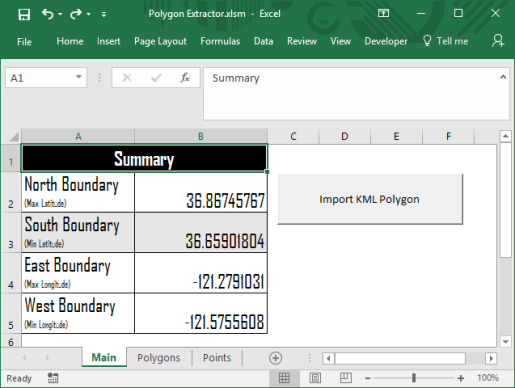
Somehow, a few weeks ago, no doubt as a result of my having enough caffeine in my system to down a small hippopotamus, I thought it would be a good idea to make a KML to CSV exporter in AutoHotkey. I can’t even claim ignorance this time—I knew VBA was a thing. But the neurons firing in my brain blazed right passed the LOGIC center and crashed head on into the AHK FIXES EVERYTHING node.
New Rule:
Don’t default to whatever language you’re most comfortable with. Unless it’s to get around using Scheme because Scheme is a bastard.
Since I’m using the coordinates in Excel, this weekend I’m adapting the AHK to live in a nice little VBA button. One I can use to get a summary of the polygon’s northernmost and southernmost point. East and west too.

Ok. So what’s different?
Luckily, all the logic from the AHK still applies. In human-speak, we want the computer to prompt the user for a kml file to load, and then we want to push all that text into a variable that we can chop up like sushi. Excel Easy has the best tutorial on how that’s done because whoever runs that place is clearly a saint.
This script is slightly different in that it’s tailored to chop up a polygon, not straight points. First, it scoops out the name and throws everything else from file into a loop that cuts out the coordinates for display in a worksheet called “Polygons.”
Thanks to CuriousJatin, I now know you can save a desired worksheet into a variable for quick reference using these lines.
Dim worksheetVariable As Worksheet
Set worksheetVariable = ActiveWorkbook.Worksheets(“Name of Worksheet“)
Really helpful if you want to copy/paste things from different sheets in the same workbook.
I was going to do a walk through of all the new functions I had to learn to make it work, but in the interest of saving time, I’m posting my VBA cheatsheet.

The Code
You have to have a worksheet in your workbook named “Polygons” before running this. That’s where Excel is going to dump your coordinates.
Dim KmlFileLoc As String, text As String, textline As String
KmlFileLoc = Application.GetOpenFilename()
'Won't read a KML, so you gotta make it a text file
KmlTxtCopy = KmlFileLoc & ".txt"
FileCopy KmlFileLoc, KmlTxtCopy
Open KmlTxtCopy For Input As #1
'EOF stands for End of File
Do Until EOF(1)
Line Input #1, textline
text = text & textline
Loop
Close #1
posName = InStr(text, "<name")
posEndName = InStr(text, "</name")
PName = Mid(text, posName + 6, posEndName - posName - 6)
posCoords = InStr(text, "coordinates") + 12
posEndCoords = InStr(text, "</coordinates")
CoordVals = Mid(text, posCoords, posEndCoords - posCoords)
Dim pwb As Worksheet
Set pwb = ActiveWorkbook.Worksheets("Polygons")
Dim l As Integer
l = 1
Do While InStr(CoordVals, ",") > 1
CommaPos = InStr(CoordVals, ",")
Longitude = Left(CoordVals, CommaPos - 1)
pwb.Cells(l + 1, 1).Value = Longitude
'Trim out that Longitude excluding the comma
CoordVals = Right(CoordVals, Len(CoordVals) - CommaPos)
'Do the Same for Latitude but in 2nd Column
CommaPos = InStr(CoordVals, ",")
Latitude = Left(CoordVals, CommaPos - 1)
pwb.Cells(l + 1, 2).Value = Latitude
CoordVals = Right(CoordVals, Len(CoordVals) - CommaPos - 1)
pwb.Cells(l + 1, 3).Value = PName
l = l + 1
Loop

ha you are through a coordinate phase . . .
LikeLiked by 1 person
Yeeeeeeeeah, I use a ton of coordinates at work. There’s gonna be a lot of VBA posts in the near future. Maybe more Blender and Processing next month 🙂
LikeLiked by 1 person
gooood
LikeLiked by 1 person
Hi, Can you post the files, I have a feeling this would be easier in Python – pandas and must faster? but the code is very elegant. I must say.
LikeLiked by 1 person
I wish I could post the file! But WordPress doesn’t let you upload KMLs or KMZs. I’ve heard Panda is best for problems like this but haven’t had a chance to try it out. I’ve got my eye on your blog, curiousjatin, in case you start up with Python tutorials 🙂
LikeLike
I may take mich time to learn. But here is one of best i found . Data analysis in Python with pandas: https://www.youtube.com/playlist?list=PL5-da3qGB5ICCsgW1MxlZ0Hq8LL5U3u9y
LikeLiked by 1 person
I’ll give it a go. Thanks curiousjatin 🙂
LikeLike